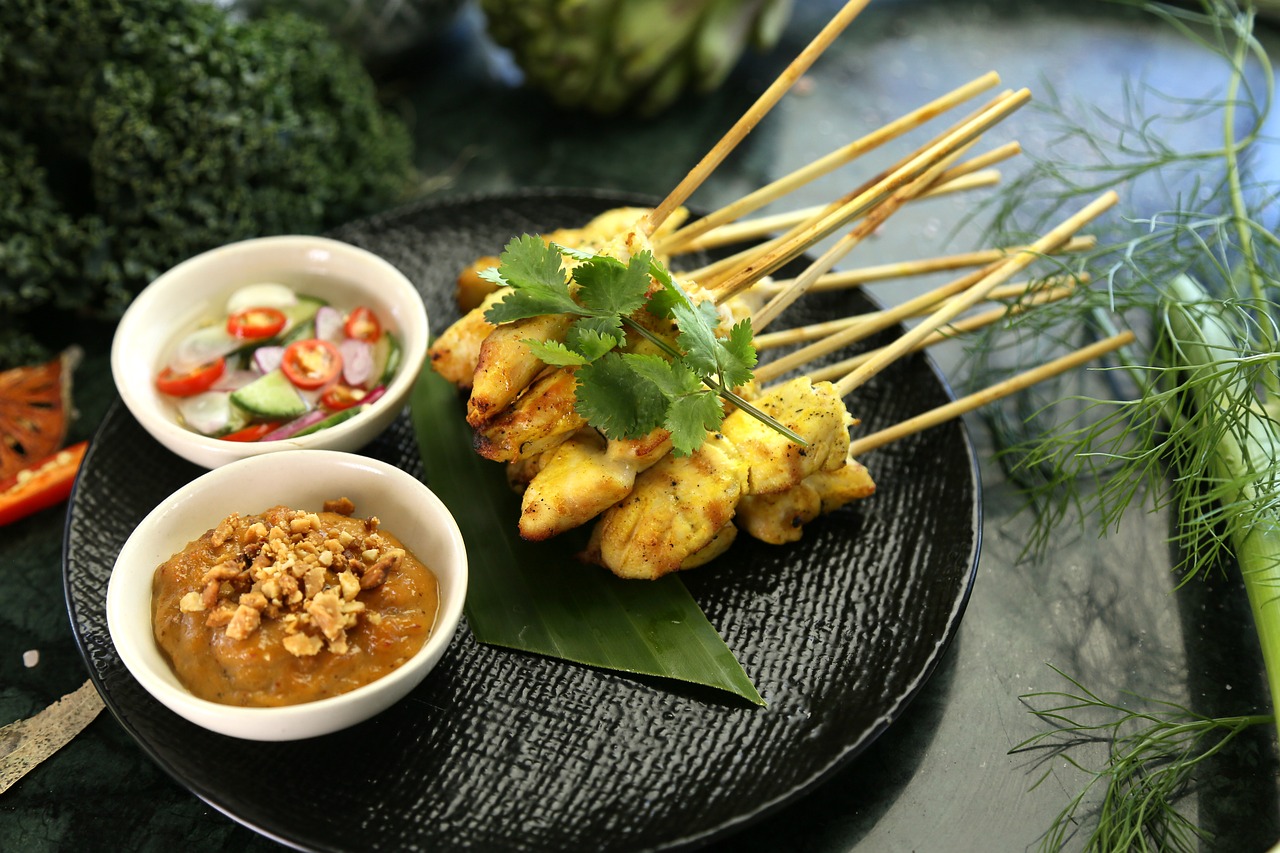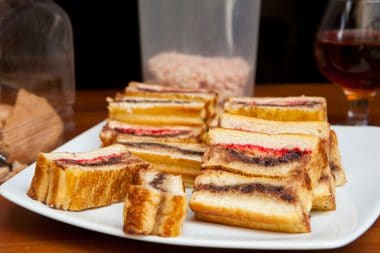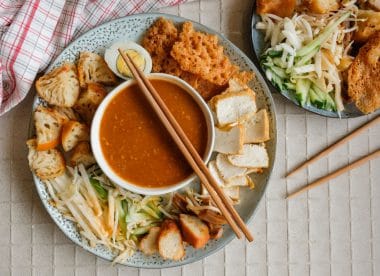
The cuisine and food in Malaysia unmistakably and characteristically reflects the ethnic diversity of the Southeast Asian country. The most important historical and current culinary influences come from the neighboring countries of China, Thailand, India and especially Sumatra.
In addition, there are more or less strong elements, recipes and ingredients from Portuguese, Dutch and British cuisine due to colonial history. Malaysia is known worldwide among chefs as a stop on the legendary, over 5,000-year-old “Spice Road”, through which the first exotic spices such as cardamom, turmeric, ginger, pepper and cinnamon once came to Europe.
Regionally, Malaysian cuisine is particularly similar to that in geographically neighboring Brunei and Singapore and has taste similarities with the Philippines. The popular meat dishes “Satay” (grilled meat on bamboo skewers), “Rendang” (curry) and the thick chili spice sauce “Sambal” are shared with Indonesia>Indonesia . A regional speciality from eastern Malaysia that is rather unusual for some Europeans are the raw, fried, grilled or sautéed larvae of the beetle Rhynchophorus ferrugineus (“sago worm”), which lives on sago palms and is called “butod” or “ulat mulong”.
Without rice, coconut and peanuts, almost no dish in Malaysia is served
Indispensable ingredients of Malaysian cuisine are, of course, rice (“Nasi”), which is always present on the table throughout Asia, the spicy shrimp paste “Belacan”, the spice paste “Rempah” with garlic, ginger and onions, and coconut (“Kelapa”), whose oil, milk, meat and water as well as peels are often used.
Soy sauce (“Masak Kicap”), turmeric (“Kunyit”), the vanilla-scented leaves of the screw palm (“Pandane”) and lemongrass (“Serai”) are just as commonly used as dried anchovies (“Ikan Bilis”), tamarinds (“Asam Jawa”) and peanuts and kukui nuts (“Buah Keras”). These ingredients are also part of typical Malaysian rice dishes such as “Nasi Himpit” in banana leaves, “Nasi dagang” with coconut milk, “Nasi kandar” with curry, “Nasi kerabu” with fish or chicken, “Nasi paprik” with chili, “Nasi ulam” with lemongrass and the national dish “Nasi Lemak” (rice fat), which is particularly popular for breakfast, with coconut milk, sambal, pepper, shrimp paste, cucumber slices as well as roasted peanuts and dried anchovies.
Enjoy the start of the day sweet or savoury

Equally popular is the almost tasteless rice porridge “Congee”, which is flavored with bamboo shoots, fish or meat, eggs, peanuts as well as shallots and soy sauce, depending on taste. A legacy of the English colonial era in the morning is toast (“Roti Bakar”) with coconut jam (“kaya”), egg, butter and sugar, usually served with tea or coffee (“kopi”).
Also widely used as breakfast are the filled dumplings “Baozi” or “Dim Sum” from China, the always freshly baked dough flatbreads “Roti” with curry, the sandwich “Murtabak” with lamb, garlic, egg and onions or chocolate and nuts as well as bean cake (“Idli”) with chutney, the pancakes “Dosa” and the semolina porridge “Upma”, which is common in South India. As in all of Southeast Asia, nutritious soups (“laksa”) with noodles made from rice, starch or wheat are popular in Malaysia early in the day.
Locals and visitors meet at noon and in the evening for a rice table
A classic for lunch or dinner in Malaysia is the rice table “Nasi Campur”, originally from Indonesia>Indonesia, where guests help themselves to a rich buffet of meat, fish and vegetable dishes in small food stalls (“Warung”) or restaurants (“Kedai Makan”) with steamed rice and pay individually according to the respective selection.
In Chinese restaurants, this “mixed rice” is also known as “economy rice”. Such buffets can include grilled chicken (“Ayam bakar”), fried chicken (“Ayam goreng”), chicken in soy sauce (“Ayam kecap”) or tomato sauce (“Ayam masak merah”). The sweet and sour fish stew “Asam pedas”, the hot and spicy curry sauce “Gulai”, grilled fish (“Ikan bakar” or “Ikan goreng”), sticky rice cooked in a bamboo cane with coconut milk (“Lemang”), the soups “me bandung” and “Sup kambing” as well as the fish pie “Otak-otak” or “Sata”, which is popular as a snack, are also available almost everywhere.
Salads can also be surprisingly zesty and fruity when eating in Malaysia
The delicious salads in Malaysia also deserve a special mention, where sweet, sour and spicy components are often elegantly and skillfully combined. Known throughout the country is the “Pecel/Pecal” with water spinach, asparagus beans, cucumbers, salt, palm sugar, galangal, Kaffir lime and garlic, which is usually served with the vegetable balls “Perkedel Kentang” or “Bakwan Jagung” fried in oil.

Especially in the north of the country, “Pasembur” made from grated cucumbers, boiled potatoes, tofu, beets and sprouts as well as fried seafood in nut marinade is a delicious specialty. In a more fruity version, Pasembur with mangoes, green apples, pineapple and yam beans is known as “Mamak rojak” or “Rojak Penang” in addition to water apples and honey as well as ginger lilies and peanuts. The traditional salad “Ulam” made from the briefly steamed leaves of the Indian pennywort (“gotu kola”) with dried anchovies, fermented crabs and sambal, which is also used in Ayurvedic medicine as a remedy for diabetes and high blood pressure, is also delicious.
Tropical fruit is eaten fresh from the tree or in sauces and desserts
The huge selection of exotic fruits is of course also noticeable in the national cuisine. Bananas and/or plantains are sold freshly fried or baked as “Pisang Goreng” at countless street stalls. Guava, honeymelon and watermelon as well as star fruit, papaya and grapefruit have also been known to us for a long time in our latitudes.
On the other hand, the very intensely fragrant fruits of the cempedak and especially durian tree may take some getting used to when you try them for the first time. The latter are used to make the hot sauce “Tempoyak”, especially in the Malaysian states of Pahang and Perak in the west of the country. In Malaysia, you can also buy jackfruit (“Nangka”), the raw or cooked berries of the native Lansi (Langsat) and Longan trees, dragon fruit (Pitaya), the rambutan fruit, which is related to lychee, as well as the fruits of the porridge apple tree (“Buah Ciku”) and the soursop, from which sugar is used to make the pudding “Dodol Sirsak” and other sweets.
The Malays also like to eat sweet delicacies throughout the day
Other typical sweet desserts or snacks are the small appetizers made of rice porridge “Kuih-Muih”, which can be bought in numerous colors and variants on almost every corner. These colorful little bites are particularly often prepared with coconut milk, palm sugar and tapioca starch. The same applies to many other typical Malaysian desserts, which are similarly ethnically representative as many of the dishes briefly outlined above.
The large ice cream sundae “Air Batu Campur”, also known by the abbreviation “ABC”, is pleasantly refreshing with adzuki beans, sweet corn and grass jelly as well as peanuts, gelatine (“agar-agar”) and condensed milk. The “Kek Batik” is reminiscent of the “Cold Dog” cake made of biscuits and chocolate, which is well-known in this country, “Dodol” are candies based on palm sugar, and “Keria Gula Melaka” is a pastry made of palm sugar and sweet potatoes. On festive days, people in Sarawak like to eat the layer cakes “Kek Lapis”, which are brightly coloured with food colouring, the no less colourful “Puding Diraja” or “Royal Pudding” with bananas, condensed milk, prunes, candied fruits, cashew nuts and fine threads of egg yolks with sugar syrup (“angel hair”) is particularly popular in the state of Pahang.

